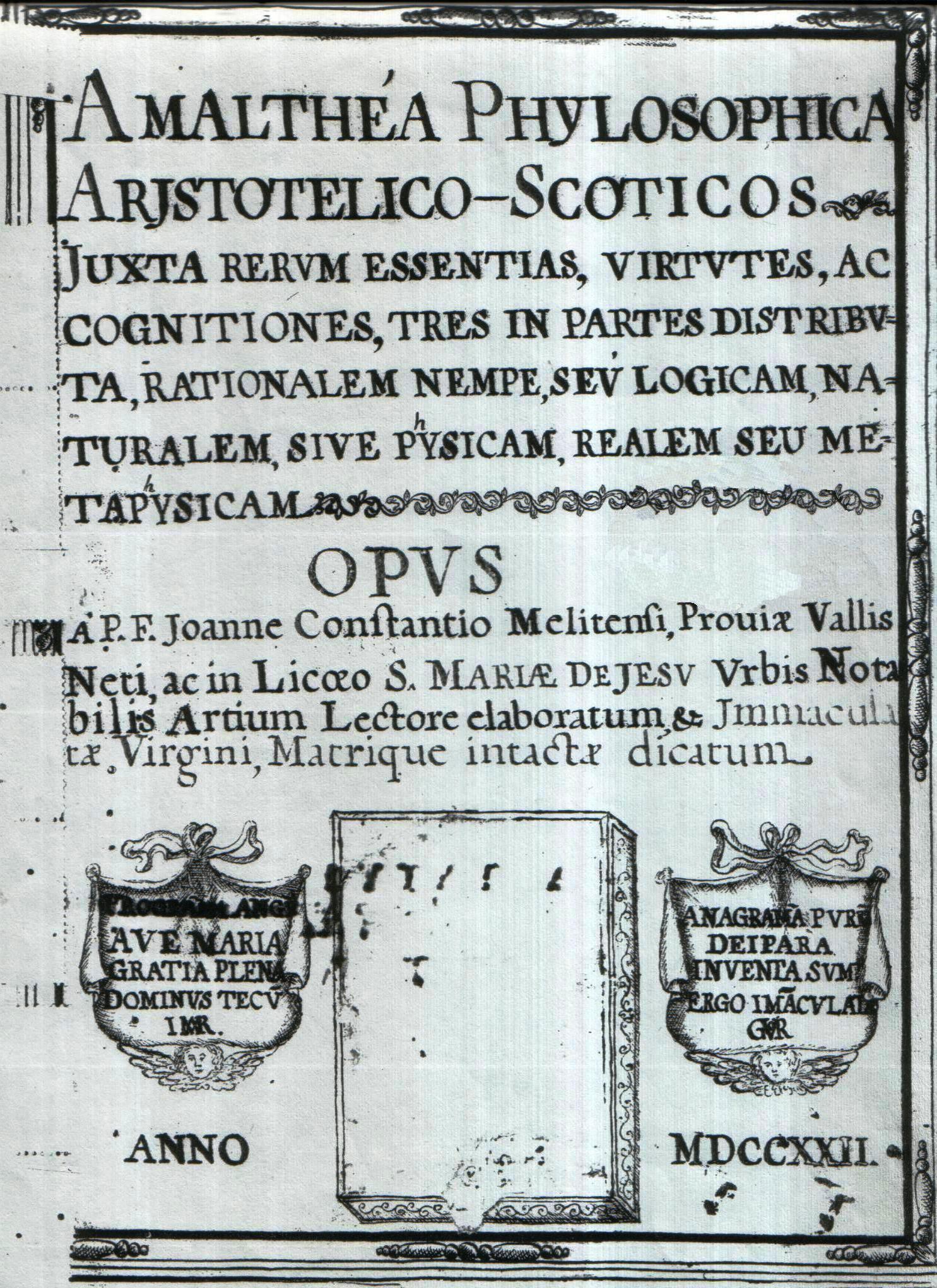John Constance Parnis on:
[Wikipedia]
[Google]
[Amazon]
 John Constance Parnis (1695–1735) was a major Maltese mediaeval philosopher who specialised mainly in
John Constance Parnis (1695–1735) was a major Maltese mediaeval philosopher who specialised mainly in
 John Constance Parnis (1695–1735) was a major Maltese mediaeval philosopher who specialised mainly in
John Constance Parnis (1695–1735) was a major Maltese mediaeval philosopher who specialised mainly in metaphysics
Metaphysics is the branch of philosophy that studies the fundamental nature of reality, the first principles of being, identity and change, space and time, causality, necessity, and possibility. It includes questions about the nature of conscio ...
, physics
Physics is the natural science that studies matter, its fundamental constituents, its motion and behavior through space and time, and the related entities of energy and force. "Physical science is that department of knowledge which r ...
, and logic
Logic is the study of correct reasoning. It includes both formal and informal logic. Formal logic is the science of deductively valid inferences or of logical truths. It is a formal science investigating how conclusions follow from premises ...
.
Life
Parnis was born atMdina
Mdina ( mt, L-Imdina ; phn, 𐤌𐤋𐤈, Maleṭ; grc, Μελίττη, Melite (ancient city), Melíttē; ar, مدينة, Madīnah; ), also known by its Italian-language titles ("Old City") and ("Notable City"), is a fortifications of Mdin ...
, Malta
Malta ( , , ), officially the Republic of Malta ( mt, Repubblika ta' Malta ), is an island country in the Mediterranean Sea. It consists of an archipelago, between Italy and Libya, and is often considered a part of Southern Europe. It lies ...
, in 1695. He began studying philosophy before he joined the Franciscans. His name at that time was John Baptist, and between 1712 and 1715 he followed courses given by Constance Vella
Constance Vella (1687–1759) was a major Maltese philosopher who specialised mainly in physics, logic, cosmology, and metaphysics. Vella's speciality is that, despite being a Scholastic, he was not an Aristotelic-Thomist one (as most of the well ...
at the Franciscans’ College of Philosophy and Literature at Rabat, Malta.
Subsequently, he joined the Franciscans in 1715, and followed his initial institutional studies with them. After his ordination to the priesthood, he began teaching theology at the ''Studium Generale'' which the Franciscans had at Naples, Italy. During this time, Parnis was also appointed the Royal Theologian to the Viceroy of Sicily.
At 35 years of age, in 1730, Parnis was elected Provincial Minister (or general superior) of his religious order for Sicily and Malta
Malta ( , , ), officially the Republic of Malta ( mt, Repubblika ta' Malta ), is an island country in the Mediterranean Sea. It consists of an archipelago, between Italy and Libya, and is often considered a part of Southern Europe. It lies ...
. While residing in Malta
Malta ( , , ), officially the Republic of Malta ( mt, Repubblika ta' Malta ), is an island country in the Mediterranean Sea. It consists of an archipelago, between Italy and Libya, and is often considered a part of Southern Europe. It lies ...
, he taught at the College of Philosophy and Literature at Rabat, Malta. This was between 1723 and 1725.
He probably spent his last ten years in Malta
Malta ( , , ), officially the Republic of Malta ( mt, Repubblika ta' Malta ), is an island country in the Mediterranean Sea. It consists of an archipelago, between Italy and Libya, and is often considered a part of Southern Europe. It lies ...
, and died here.
Extant work
Composition
It seems that only one major work of Parnis survived. This is the ''Amalthéa Aristotelico-Scoticos'' (A Compendium of Aristotelian-Scotist Philosophy), and still exists in manuscript form at the Franciscan Archive in Valletta,Malta
Malta ( , , ), officially the Republic of Malta ( mt, Repubblika ta' Malta ), is an island country in the Mediterranean Sea. It consists of an archipelago, between Italy and Libya, and is often considered a part of Southern Europe. It lies ...
(''unmarked'').''Ibid.'', vol. I, p. 15. The work was composed during the 1723/24 academic year (and finalised on February 19, 1724). It is a very elaborate composition made up of 394 back-to-back folios, and written in Parnis’ charming calligraphy.
The work is divided in three main parts. They respectively deal with logic, physics, and metaphysics. Though they contain a philosophy according to Scholasticism
Scholasticism was a medieval school of philosophy that employed a critical organic method of philosophical analysis predicated upon the Aristotelian 10 Categories. Christian scholasticism emerged within the monastic schools that translate ...
and Aristotelianism, all of them take the perspective of John Duns Scotus.
Appreciation
All parts are dealt with by Parnis is great detail. His philosophical explanations are long, meticulous and comprehensive. Despite the fact that he divides his work in a traditional manner – that is, in Disputations, Questions, and Treatises – Parnis does not limit his comments with any conventional modes of analysis. Throughout the whole work, in fact, Parnis expressly states his own opinion, and contrasts it with those of classical and contemporary philosophers. Since the massive work has never been transcribed and much less translated to any modern language, its teachings have not been studied professionally.References
Sources
* Mark Montebello, ''Il-Ktieb tal-Filosofija f’Malta'' (''A Source Book of Philosophy in Malta''), PIN Publications, Malta, 2001.See also
Philosophy in Malta
Philosophy in Malta refers to the philosophy of Maltese nationals or those of Maltese descent, whether living in Malta or abroad, whether writing in their native Maltese language or in a foreign language. Though Malta is not more than a tiny Euro ...
{{DEFAULTSORT:Parnis, John Constance
18th-century Maltese philosophers
Scholastic philosophers
1695 births
1735 deaths
People from Mdina